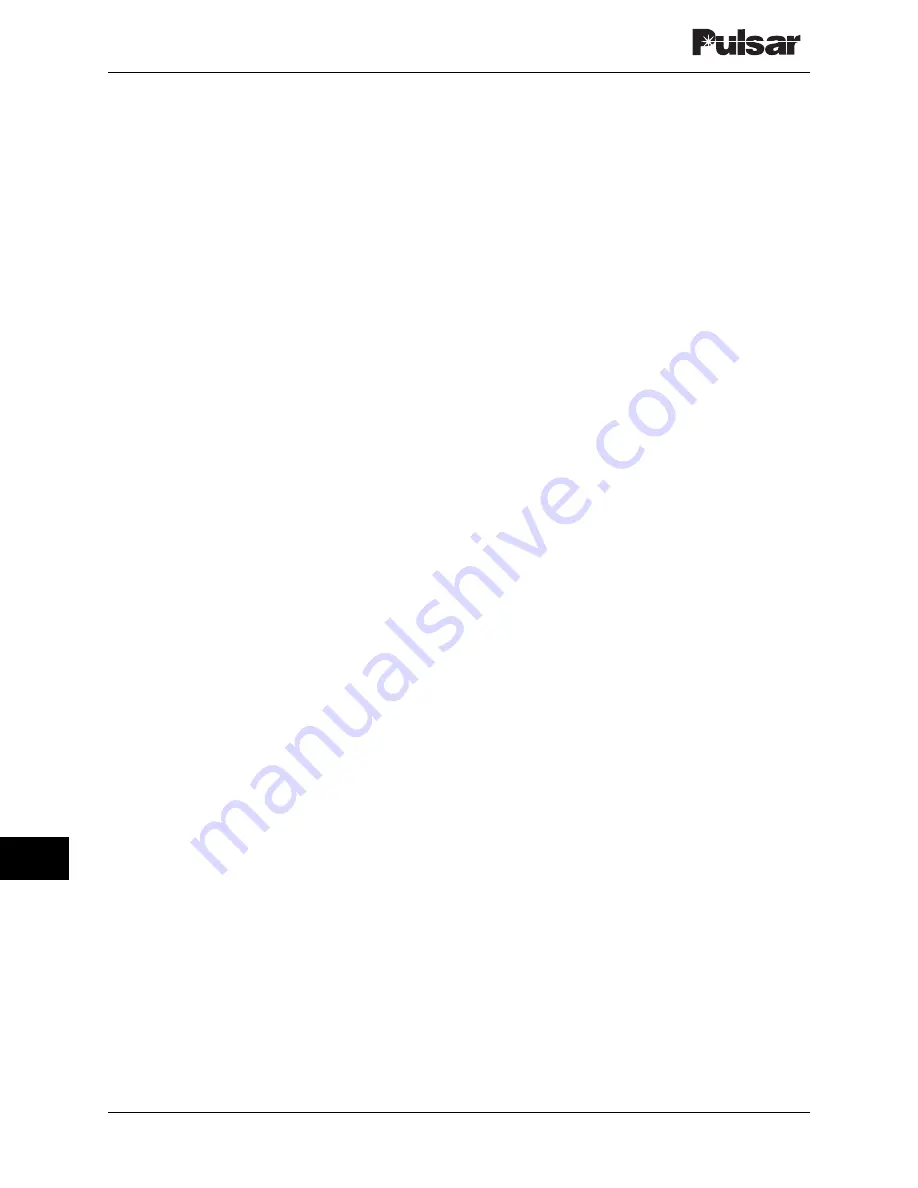
Page 16–20
October 2003
TC–10B System Manual
Technologies, Inc.
Checkback Period
As mentioned above, the checkback period is
enabled when the Interval Type is set to
"periodic". If you wanted three tests per day and
really did not care about the time of day when they
occurred, you could set this time to, say, 8 hours.
Masters attempt periodic checkback tests at
exactly this time, in our case eight hours since the
last test. Remotes have a grace period before they,
too, attempt a checkback test, if they have not
heard from the master. For example, remote #1
would do a checkback test after eight hours and
five minutes, if it did not receive a checkback test
from another module.
Example:
set period 8–The module executes a
checkback test eight hours after the last
test, if it is a master. If it is remote #1, it
executes a test at 8:05, if it does not receive
a checkback request from the master before
this time.
Loopback Duration
The loopback duration specifies how long a
module holds the carrier on during a loopback test.
Loopback tests are performed at both high and low
power. If you are at remote #1 and request a
loopback test at the master, it turns the carrier on
high power then on low power for the duration of
the time. You can use loopback tests to set the
sensitivity of your local receiver or other such
tasks. The range of times is four to 60 seconds.
You can request loopback tests in three ways: (1)
with this command (e.g., do loop > 1 requests
remote #1 to do a loopback test), (2) by pressing
and holding the top front panel switch, or (3) by
closing the switch connected to the rear input
TB6-1/TB6-2 for five seconds.
Example:
set loop 25–Sets the loopback duration to 25
seconds.
Carrier Recovery Period
When the master is in carrier recovery mode after
failing a checkback test, it begins initiating
checkback tests according to the carrier recovery
period. For example, if the carrier recovery period
is 15 minutes, the master tries another checkback
test every 15 minutes. It remains in carrier
recovery mode and continues to initiate tests every
15 minutes, until it has successfully completed
three consecutive checkback tests. At that time, it
shifts back to the normal mode, either periodic or
timed checkback tests.
Example:
set carrier 45–Sets the carrier recovery
period to 45 minutes
Carrier Recovery Window
The carrier recovery window is a time limit for the
delayed alarm. If a module goes into carrier
recovery mode and does not recover before this
time limit, it sets the delayed alarm. If any user-
programmable output is set to delayed alarm, it
becomes active. The main reason for having a
carrier recovery window and delayed alarm is to
cut down on nuisance alarms. With this window
and the delayed alarm, you can design a system
that only alerts you when a true, long-term
problem exists. The valid range for this window is
1 to 24 hours.
Example:
set window 3–Sets the window to three hours.
Auto Clock Sync
When the auto clock sync is enabled, the master
synchronizes all remote clocks to its own time,
starting at 12:30 a.m. In practice, the synchroniza-
tion is rough, within about +/- 2 seconds. But that
is sufficiently accurate for Timed checkback
testing.
Examples:
set sync off (or)
set sync disable
Содержание TC-10B
Страница 2: ...Technologies Inc...
Страница 12: ...Technologies Inc...
Страница 22: ...Page 1 10 October 2003 TC 10B System Manual Technologies Inc Technologies Inc USER NOTES...
Страница 44: ...Page 2 22 October 2003 TC 10B System Manual Technologies Inc Technologies Inc USER NOTES...
Страница 53: ...3 Figure 3 3 TC 10B Mechanical Outline Drawing 1354D48...
Страница 56: ...Page 3 12 October 2003 TC 10B System Manual Technologies Inc Technologies Inc USER NOTES...
Страница 58: ...Page 4 2 October 2003 TC 10B System Manual Technologies Inc Figure 4 1 Extender Board...
Страница 90: ...Figure 9 2 TC 10B TCF 10B Power Supply Component Location 1617C38...
Страница 91: ...9 Figure 9 3 TC 10B TCF 10B Power Supply Schematic 1617C39...
Страница 92: ...Page 9 6 October 2003 TC 10B System Manual Technologies Inc Technologies Inc USER NOTES...
Страница 97: ...10 Figure 10 2 TC 10B Keying PC Board 1495B69...
Страница 98: ...Figure 10 3 TC 10B Keying Schematic 1606C29...
Страница 104: ...Figure 11 3 TC 10B TCF 10B Transmitter PC Board 1500B10...
Страница 106: ...Figure 11 5 TC 10B Transmitter Block Diagram 1610C09...
Страница 107: ...11 Figure 11 6 TC 10B Optional TTL Transmitter Component layout CC20 TXMA1 001...
Страница 112: ...Figure 12 2 TC 10B TCF 10B 10W PA PC Board 1495B73...
Страница 113: ...12 Figure 12 3 10W PA Schematic 1606C33...
Страница 114: ...Page 12 6 October 2003 TC 10B System Manual Technologies Inc Technologies Inc USER NOTES...
Страница 117: ...13 Figure 13 2 TC 10B TCF 10B RF Interface PC Board 1609C32...
Страница 118: ...Figure 13 3 TC 10B TCF 10B RF Interface Schematic 1609C32 2...
Страница 126: ...Page 14 8 October 2003 TC 10B System Manual Technologies Inc Technologies Inc USER NOTES...
Страница 132: ...Figure 15 3 TC 10B Receiver Output PC Board CC50RXSM...
Страница 133: ...15 Figure 15 4 TC 10B Receiver Output Schematic CC30RXSM...
Страница 134: ...Page 15 8 October 2003 TC 10B System Manual Technologies Inc Technologies Inc USER NOTES...
Страница 178: ...Page 16 44 October 2003 TC 10B System Manual Technologies Inc Technologies Inc USER NOTES...
Страница 184: ...Figure 17 3 Voice Adapter Module PC Board C020VADMN...
Страница 189: ......
Страница 190: ...Technologies Inc...
















































